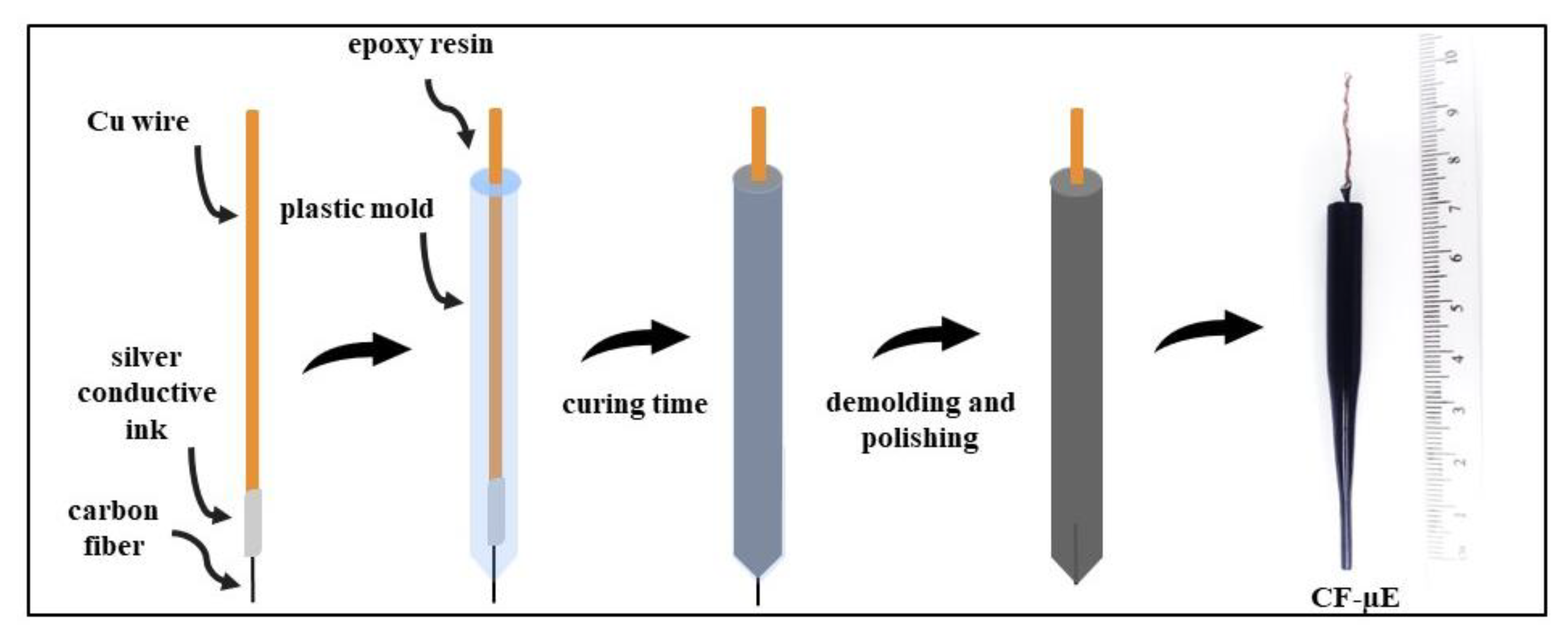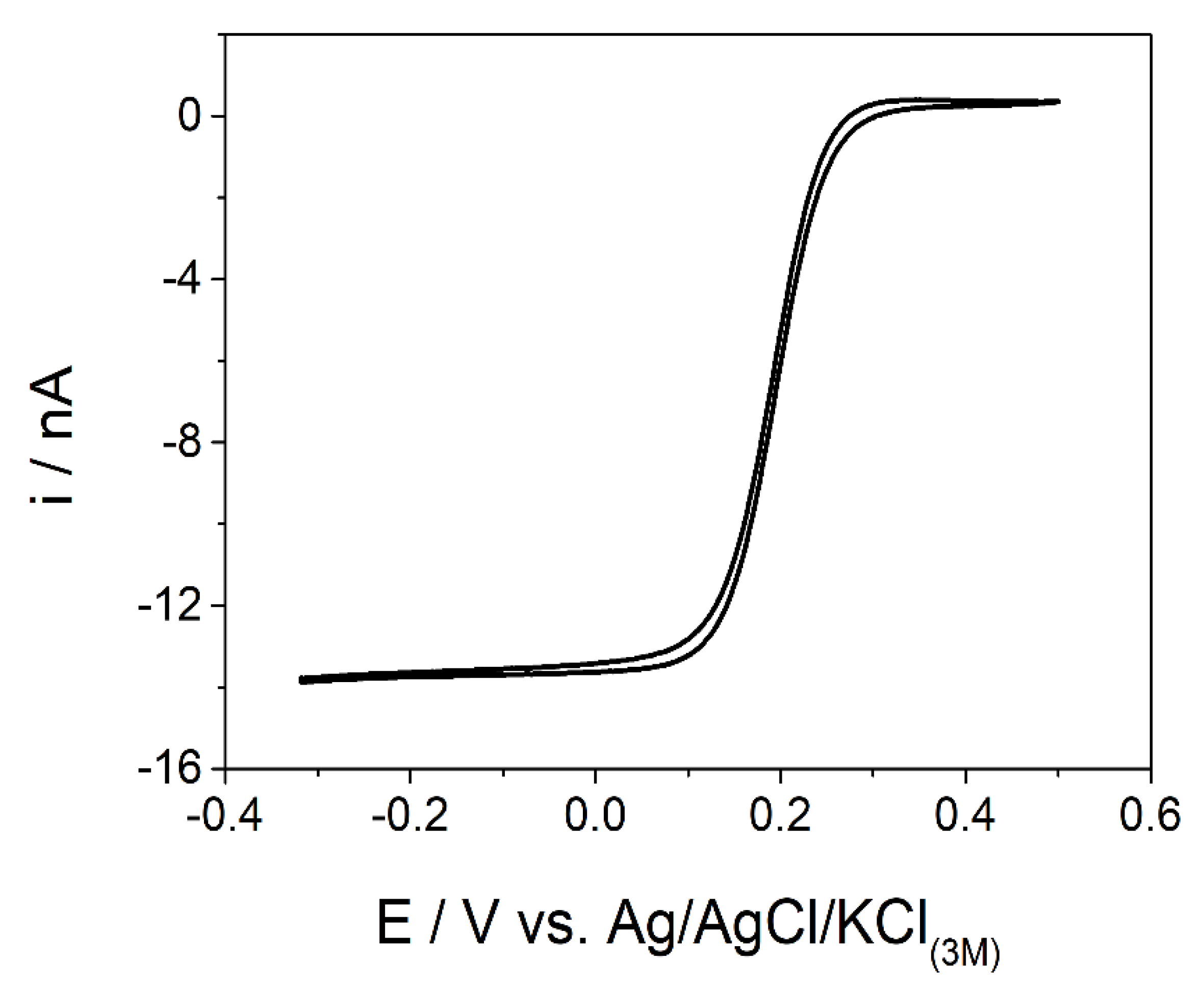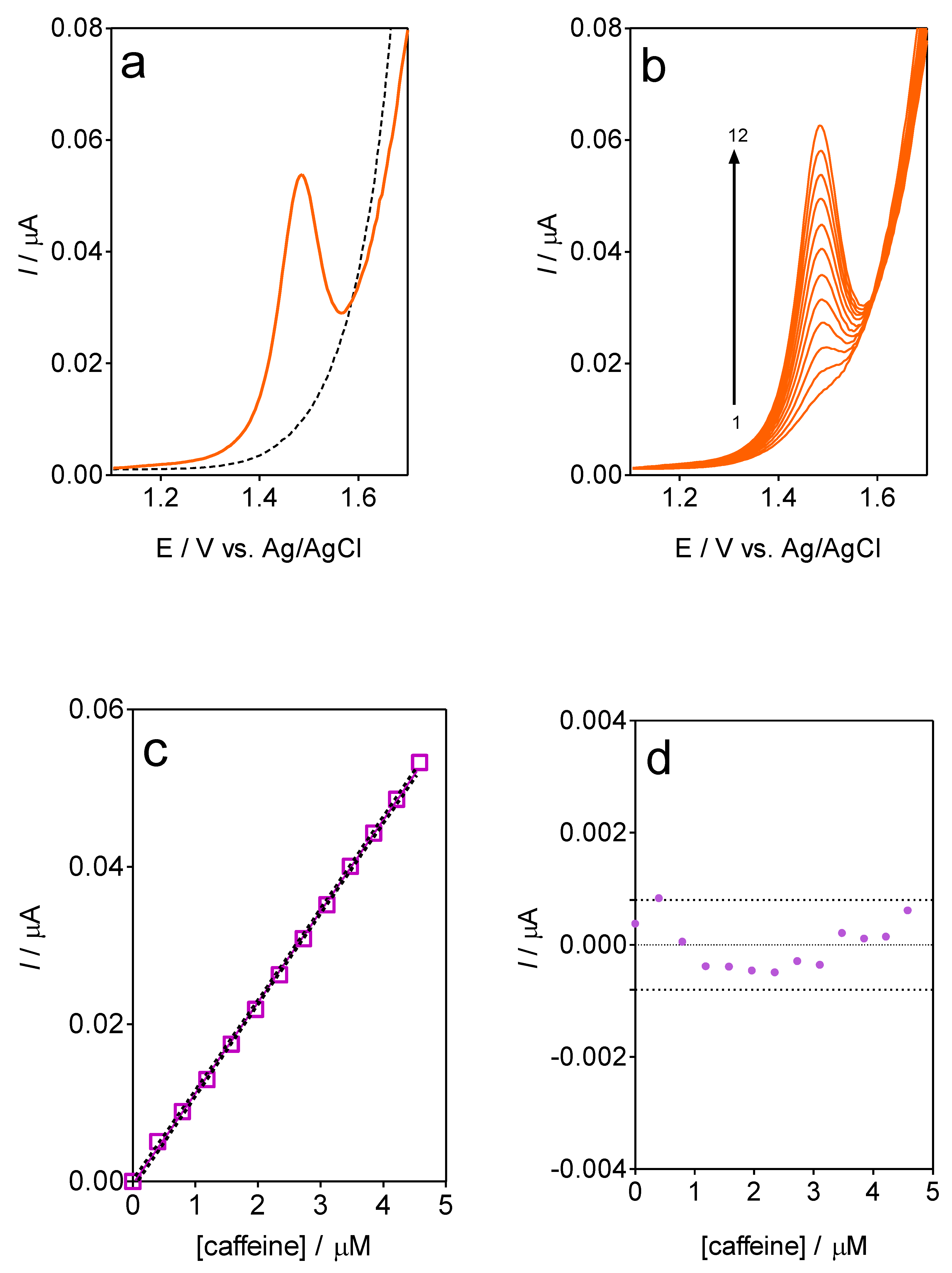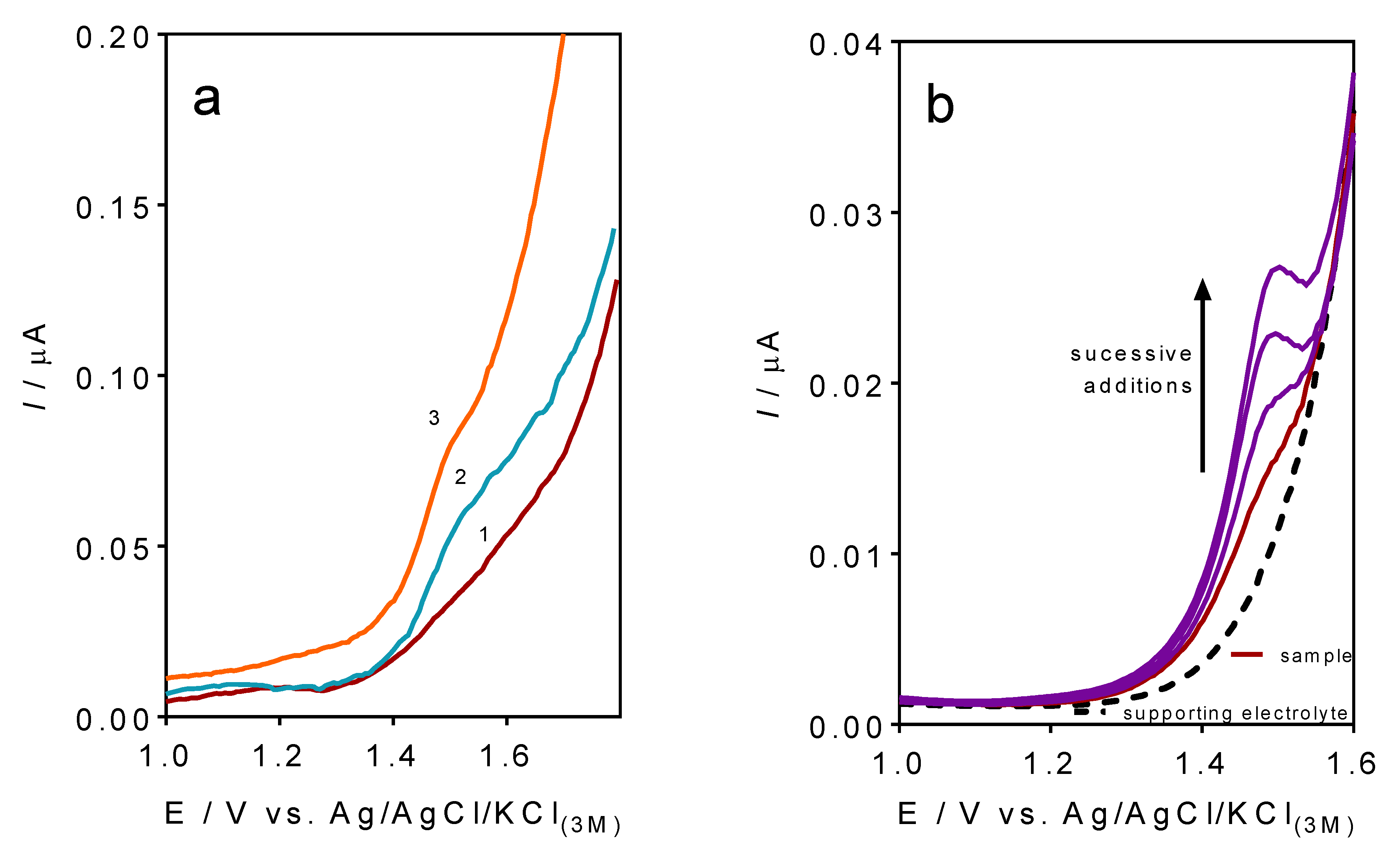Probing the Use of Homemade Carbon Fiber Microsensor for Quantifying Caffeine in Soft Beverages
Abstract
1. Introduction
2. Experimental Methods
2.1. Reagents
2.2. Homemade CF-µE Fabrication
2.3. Electrochemical Measurements
2.4. Electrochemical Determination of Caffeine in Beverages
3. Results and Discussion
3.1. Fabrication and Characterization of the CF-µE
3.2. Cyclic Voltammetry Experiments in Presence of Caffeine
3.3. Differential Pulse Voltammetric Experiments
3.4. Caffeine Determination in Soft Beverage Samples
3.5. Interference Studies
4. Conclusions
Author Contributions
Funding
Institutional Review Board Statement
Informed Consent Statement
Data Availability Statement
Conflicts of Interest
References
- Švorc, L.; Tomčík, P.; Svítková, J.; Rievaj, M.; Bustin, D. Voltammetric determination of caffeine in beverage samples on bare boron-doped diamond electrode. Food Chem. 2012, 135, 1198–1204. [Google Scholar] [CrossRef] [PubMed]
- Araujo, D.; Brito, C.; de Oliveira, S.D.; Silva, D.; Martinez-Huitle, C.; Aragao, C. Platinum sensor for quantifying caffeine in drug formulations. Curr. Pharm. Anal. 2014, 10, 231–238. [Google Scholar] [CrossRef]
- Rostagno, M.A.; Manchón, N.; D’Arrigo, M.; Guillamón, E.; Villares, A.; García-Lafuente, A.; Ramos, A.; Martínez, J.A. Fast and simultaneous determination of phenolic compounds and caffeine in teas, mate, instant coffee, soft drink and energetic drink by high-performance liquid chromatography using a fused-core column. Anal. Chim. Acta 2011, 685, 204–211. [Google Scholar] [CrossRef] [PubMed]
- Rajabi Khorrami, A.; Rashidpur, A. Development of a fiber coating based on molecular sol-gel imprinting technology for selective solid-phase micro extraction of caffeine from human serum and determination by gas chromatography/mass spectrometry. Anal. Chim. Acta 2012, 727, 20–25. [Google Scholar] [CrossRef] [PubMed]
- Rahim, A.A.; Nofrizal, S.; Saad, B. Rapid tea catechins and caffeine determination by HPLC using microwave-assisted extraction and silica monolithic column. Food Chem. 2014, 147, 262–268. [Google Scholar] [CrossRef] [PubMed]
- Al-Othman, Z.A.; Aqel, A.; Alharbi, M.K.E.; Yacine Badjah-Hadj-Ahmed, A.; Al-Warthan, A.A. Fast chromatographic determination of caffeine in food using a capillary hexyl methacrylate monolithic column. Food Chem. 2012, 132, 2217–2223. [Google Scholar] [CrossRef]
- Hadad, G.M.; Abdel Salam, R.A.; Soliman, R.M.; Mesbah, M.K. Rapid and simultaneous determination of antioxidant markers and caffeine in commercial teas and dietary supplements by HPLC-DAD. Talanta 2012, 101, 38–44. [Google Scholar] [CrossRef] [PubMed]
- Svorc, L. Determination of caffeine: A comprehensive review on electrochemical methods. Int. J. Electrochem. Sci. 2013, 8, 5755–5773. [Google Scholar]
- Vasilescu, I.; Eremia, S.A.V.; Penu, R.; Albu, C.; Radoi, A.; Litescu, S.C.; Radu, G.L. Disposable dual sensor array for simultaneous determination of chlorogenic acid and caffeine from coffee. RSC Adv. 2015, 5, 261–268. [Google Scholar] [CrossRef]
- Monteiro, M.K.S.; da Silva, D.R.; Quiroz, M.A.; Vilar, V.J.P.; Martínez-Huitle, C.A.; dos Santos, E.V. Applicability of cork as novel modifiers to develop electrochemical sensor for caffeine determination. Materials 2021, 14, 37. [Google Scholar] [CrossRef]
- Monteiro, M.K.S.; Paiva, S.S.M.; da Silva, D.R.; Vilar, V.J.P.; Martínez-Huitle, C.A.; dos Santos, E.V. Novel cork-graphite electrochemical sensor for voltammetric determination of caffeine. J. Electroanal. Chem. 2019, 839, 283–289. [Google Scholar] [CrossRef]
- de Araújo, D.M.; Paiva, S.d.S.S.M.; Henrique, J.M.M.; Martínez-Huitle, C.A.; dos Santos, E.V. Green composite sensor for monitoring hydroxychloroquine in different water matrix. Materials 2021, 14, 4990. [Google Scholar] [CrossRef]
- Ören, T.; Anık, Ü. Voltammetric determination of caffeine by using gold nanoparticle-glassy carbon paste composite electrode. Measurement 2017, 106, 26–30. [Google Scholar] [CrossRef]
- Martínez-Huitle, C.A.; Suely Fernandes, N.; Ferro, S.; de Battisti, A.; Quiroz, M.A. Fabrication and application of Nafion®-modified boron-doped diamond electrode as sensor for detecting caffeine. Diam. Relat. Mater. 2010, 19, 1188–1193. [Google Scholar] [CrossRef]
- Rick Lopes Da Silva, Á.; Medeiros De Araújo, D.; Bernardo Sabino Da Silva, E.; Serradella Vieira, D.; de Kássio Vieira Monteiro, N.; Martínez-Huitle, C.A. Understanding the behavior of caffeine on a boron-doped diamond surface: Voltammetric, DFT, QTAIM and ELF Studies. New J. Chem. 2017, 41, 7766–7774. [Google Scholar] [CrossRef]
- Yardim, Y.; Keskin, E.; Şentürk, Z. Voltammetric determination of mixtures of caffeine and chlorogenic acid in beverage samples using a boron-doped diamond electrode. Talanta 2013, 116, 1010–1017. [Google Scholar] [CrossRef] [PubMed]
- Wong, A.; Santos, A.M.; Silva, T.A.; Fatibello-Filho, O. Simultaneous determination of isoproterenol, acetaminophen, folic acid, propranolol and caffeine using a sensor platform based on carbon black, graphene oxide, copper nanoparticles and PEDOT:PSS. Talanta 2018, 183, 329–338. [Google Scholar] [CrossRef]
- Mahanthappa, M.; Yellappa, S.; Kottam, N.; Srinivasa Rao Vusa, C. Sensitive determination of caffeine by copper sulphide nanoparticles modified carbon paste electrode. Sens. Actuators A Phys. 2016, 248, 104–113. [Google Scholar] [CrossRef]
- Wang, Y.; Ding, Y.; Li, L.; Hu, P. Nitrogen-doped carbon nanotubes decorated Poly (L-Cysteine) as a novel, ultrasensitive electrochemical sensor for simultaneous determination of theophylline and caffeine. Talanta 2018, 178, 449–457. [Google Scholar] [CrossRef]
- Habibi, B.; Abazari, M.; Pournaghi-Azar, M.H. A carbon nanotube modified electrode for determination of caffeine by differential pulse voltammetry. Chin. J. Catal. 2012, 33, 1783–1790. [Google Scholar] [CrossRef]
- AL-Gahouari, T.; Bodkhe, G.; Sayyad, P.; Ingle, N.; Mahadik, M.; Shirsat, S.M.; Deshmukh, M.; Musahwar, N.; Shirsat, M. Electrochemical Sensor: L-Cysteine induced selectivity enhancement of electrochemically reduced graphene oxide–multiwalled carbon nanotubes hybrid for detection of lead (Pb2+) ions. Front. Mater. 2020, 7, 68. [Google Scholar] [CrossRef]
- Sun, J.Y.; Huang, K.J.; Wei, S.Y.; Wu, Z.W.; Ren, F.P. A graphene-based electrochemical sensor for sensitive determination of caffeine. Colloids Surf. B Biointerfaces 2011, 84, 421–426. [Google Scholar] [CrossRef] [PubMed]
- Jeevagan, A.J.; John, S.A. Electrochemical determination of caffeine in the presence of paracetamol using a self-assembled monolayer of non-peripheral amine substituted copper(II) phthalocyanine. Electrochim. Acta 2012, 77, 137–142. [Google Scholar] [CrossRef]
- Ghoreishi, S.M.; Attaran, A.M.; Amin, A.M.; Khoobi, A. Multiwall carbon nanotube-modified electrode as a nanosensor for electrochemical studies and stripping voltammetric determination of an antimalarial drug. RSC Adv. 2015, 5, 14407–14415. [Google Scholar] [CrossRef]
- Rassaei, L.; Marken, F.; Sillanpää, M.; Amiri, M.; Cirtiu, C.M.; Sillanpää, M. Nanoparticles in electrochemical sensors for environmental monitoring. Trends Anal. Chem. 2011, 30, 1704–1715. [Google Scholar] [CrossRef]
- Nebel, C.E.; Yang, N.; Uetsuka, H.; Osawa, E.; Tokuda, N.; Williams, O. Diamond nano-wires, a new approach towards next generation electrochemical gene sensor platforms. Diam. Relat. Mater. 2009, 18, 910–917. [Google Scholar] [CrossRef]
- Carolina Torres, A.; Barsan, M.M.; Brett, C.M.A. Simple electrochemical sensor for caffeine based on carbon and nafion-modified carbon electrodes. Food. Chem. 2014, 149, 215–220. [Google Scholar] [CrossRef]
- Siqueira, G.P.; de Faria, L.V.; Rocha, R.G.; Matias, T.A.; Richter, E.M.; Muñoz, R.A.A.; da Silva, I.S.; Dantas, L.M.F. Nanoporous gold microelectrode arrays using microchips: A highly sensitive and cost-effective platform for electroanalytical applications. J. Electroanal. Chem. 2022, 925, 116880. [Google Scholar] [CrossRef]
- Jose, J.; Subramanian, V.; Shaji, S.; Sreeja, P.B. An electrochemical sensor for nanomolar detection of caffeine based on Nicotinic Acid Hydrazide Anchored on Graphene Oxide (NAHGO). Sci. Rep. 2021, 11, 1–11. [Google Scholar] [CrossRef]
- Sachidananda, T.G.; Chikkanagoudar, R.N.; Pattar, N.; Nandurkar, S. Investigations of the influence of geometrical parameters of carbon nanotube material for sensor and MEMS applications. Mater. Today Proc. 2022, 63, 745–750. [Google Scholar] [CrossRef]
- Mao, S.; Lu, G.; Chen, J. Nanocarbon-based gas sensors: Progress and challenges. J. Mater. Chem. A Mater. 2014, 2, 5573–5579. [Google Scholar] [CrossRef]
- Wang, B.; Wen, X.; Chiou, P.-Y.; Maidment, N.T. Pt nanoparticle-modified carbon fiber microelectrode for selective electrochemical sensing. Electroanalysis 2019, 31, 1641–1645. [Google Scholar] [CrossRef]
- Aquino de Queiroz, J.L.; Martínez-Huitle, C.A.; Castro, P.S. Real time monitoring of in situ generated hydrogen peroxide in electrochemical advanced oxidation reactors using an integrated Pt microelectrode. Talanta 2020, 218, 121133. [Google Scholar] [CrossRef] [PubMed]
- Brunetti, B.; Desimoni, E.; Casati, P. Determination of caffeine at a nation-covered glassy carbon electrode. Electroanalysis 2007, 19, 385–388. [Google Scholar] [CrossRef]
- Arroyo-Gómez, J.J.; Villarroel-Rocha, D.; de Freitas-Araújo, K.C.; Martínez-Huitle, C.A.; Sapag, K. Applicability of activated carbon obtained from peach stone as an electrochemical sensor for detecting caffeine. J. Electroanal. Chem. 2018, 822, 171–176. [Google Scholar] [CrossRef]
- Khoo, W.Y.H.; Pumera, M.; Bonanni, A. Graphene platforms for the detection of caffeine in real samples. Anal. Chim. Acta 2013, 804, 92–97. [Google Scholar] [CrossRef]
- Currie, L.A. International Union of Pure and Applied Chemistry Nomenclature in Evaluation of Analytical Methods Including Detection and Quantification Capabilities. Pure Appl. Chem. 1995, 67, 1699–1723. [Google Scholar] [CrossRef]
- Desimoni, E.; Brunetti, B. About estimating the limit of detection of heteroscedastic analytical systems. Anal. Chim. Acta 2009, 655, 30–37. [Google Scholar] [CrossRef]
- Danzer, K.; Currie, L.A. Guideline for calibration in analytical chemistry—Part 1. Fundamentals and single component calibration. Pure Appl. Chem. 1998, 70, 993–1014. [Google Scholar] [CrossRef]
- Redivo, L.; Stredanský, M.; DeAngelis, E.; Navarini, L.; Resmini, M.; Švorc, Ĺ. Bare carbon electrodes as simple and efficient sensors for the quantification of caffeine in commercial beverages. R. Soc. Open Sci. 2018, 5, 172146. [Google Scholar] [CrossRef]
- Lourenção, B.C.; Antigo Medeiros, R.; Rocha-Filho, R.C.; Mazo, L.H.; Fatibello-Filho, O. Simultaneous voltammetric determination of paracetamol and caffeine in pharmaceutical formulations using a boron-doped diamond electrode. Talanta 2009, 78, 748–752. [Google Scholar] [CrossRef] [PubMed]
- Jesu Amalraj, A.J.; Umesh, N.; Wang, S.F. Rational design of platinum assimilated 3-D zinc cobalt oxide flowers for the electrochemical detection of caffeine in beverage and energy drink. J. Ind. Eng. Chem. 2022, 106, 205–213. [Google Scholar] [CrossRef]
- Tyszczuk-Rotko, K.; Bęczkowska, I. Nafion covered lead film electrode for the voltammetric determination of caffeine in beverage samples and pharmaceutical formulations. Food Chem. 2015, 172, 24–29. [Google Scholar] [CrossRef] [PubMed]
- Yang, S.; Yang, R.; Li, G.; Qu, L.; Li, J.; Yu, L. Nafion/Multi-wall carbon nanotubes composite film coated glassy carbon electrode for sensitive determination of caffeine. J. Electroanal. Chem. 2010, 639, 77–82. [Google Scholar] [CrossRef]
- Farag, A.S.; Pravcová, K.; Česlová, L.; Vytřas, K.; Sýs, M. Simultaneous determination of caffeine and pyridoxine in energy drinks using differential pulse voltammetry at glassy carbon electrode modified with Nafion®. Electroanalysis 2019, 31, 1494–1499. [Google Scholar] [CrossRef]
- Guo, S.; Zhu, Q.; Yang, B.; Wang, J.; Ye, B. Determination of caffeine content in tea based on Poly(Safranine T) electroactive film modified electrode. Food Chem. 2011, 129, 1311–1314. [Google Scholar] [CrossRef]
- Sun, J.Y.; Huang, K.J.; Wei, S.Y.; Wu, Z.W. Application of cetyltrimethylammonium bromide–graphene modified electrode for sensitive determination of caffeine. Can. J. Chem. 2011, 89, 697–702. [Google Scholar] [CrossRef]
- Amare, M.; Admassie, S. Polymer modified glassy carbon electrode for the electrochemical determination of caffeine in coffee. Talanta 2012, 93, 122–128. [Google Scholar] [CrossRef]
- Okutan, M.; Boran, F.; Alver, E.; Asan, A. One-pot synthesize of graphene-ZrO2 nanocomposite: A novel modified glassy carbon electrode for the detection of caffeine in beverage samples. Mater. Chem. Phys. 2022, 280, 125846. [Google Scholar] [CrossRef]
- Murugan, E.; Dhamodharan, A. Separate and simultaneous determination of vanillin, theophylline and caffeine using molybdenum disulfide embedded polyaniline/graphitic carbon nitrite nanocomposite modified glassy carbon electrode. Diam. Relat. Mater. 2021, 120, 108684. [Google Scholar] [CrossRef]
- Alizadeh, T.; Ganjali, M.R.; Zare, M.; Norouzi, P. Development of a voltammetric sensor based on a Molecularly Imprinted Polymer (MIP) for caffeine measurement. Electrochim. Acta 2010, 55, 1568–1574. [Google Scholar] [CrossRef]
- Aklilu, M.; Tessema, M.; Redi-Abshiro, M. Indirect voltammetric determination of caffeine content in coffee using 1,4-Benzoquinone modified carbon paste electrode. Talanta 2008, 76, 742–746. [Google Scholar] [CrossRef]
- Jiang, L.; Ding, Y.; Jiang, F.; Li, L.; Mo, F. Electrodeposited nitrogen-doped graphene/carbon nanotubes nanocomposite as enhancer for simultaneous and sensitive voltammetric determination of caffeine and vanillin. Anal. Chim. Acta 2014, 833, 22–28. [Google Scholar] [CrossRef] [PubMed]
- Filik, H.; Avan, A.A.; Mümin, Y. Simultaneous electrochemical determination of caffeine and vanillin by using Poly(Alizarin Red S) modified glassy carbon electrode. Food Anal. Methods 2017, 10, 31–40. [Google Scholar] [CrossRef]
- Tadesse, Y.; Tadese, A.; Saini, R.C.; Pal, R. Cyclic voltammetric investigation of caffeine at anthraquinone modified carbon paste electrode. Int. J. Electrochem. 2013, 2013, 849327. [Google Scholar] [CrossRef]







| Electrodes | Sample | Method | Electrolyte | LOD/µmol L−1 | LOD/ppm | Ref. |
|---|---|---|---|---|---|---|
| 1 CA-ZnFe-modified GCE | Coffee and commercial beverages | DPV | 1 mol L−1 H2SO4 | 10.0 | 0.194 | [35] |
| 2 CuS NPs MCPE | Commercial tea and coffee samples | DPV | Acetate buffer (pH 7.0) | 0.018 | 0.00035 | [18] |
| Pt@ZnCo2O4 | Beverage and energy drink | Amperometric | 0.1 mol L−1 H2SO4 | 0.05 | 0.000971 | [42] |
| Nafion/GCE | Cola beverages | DPV | 0.1 mol L−1 H2SO4 | 0.798 | 0.0155 | [34] |
| Nafio-covered lead film electrode | Tea, coffee, soft and energy drink samples, and pharmaceutical formulation | DPV | 0.1 mol L−1 H2SO4 | 7.98 | 0.155 | [43] |
| Nafion/GR/GCE | Soft drinks | DPV | 0.01 mol L−1 H2SO4 | 0.12 | 0.00233 | [22] |
| Nafion/MWCNTs/GCE | Beverage samples | DPV | 0.01 mol L−1 H2SO4 | 0.23 | 0.00447 | [44] |
| Nafion/BDDE | Real cola samples | DPV | 0.2 mol L−1 H2SO4 | 0.10 | 0.00194 | [14] |
| Nafion®/GCE | Energy drinks | DPV | 0.1 mol L−1 Britton–Robinson buffer (pH 4.5) | 18.9 | 0.367 | [45] |
| Nafion/PST/GCE | Tea | LSD | H2SO4 solution (pH 1.0) | 0.10 | 0.00194 | [46] |
| CTAB/GR/GCE | Soft drink sample | DPV | 0.01 mol L−1 H2SO4 | 0.091 | 0.00177 | [47] |
| PAHNSA/GCE | Coffee extracts | SWV | Acetate buffer solution (pH 5) | 0.137 | 0.00266 | [48] |
| Pt/CNTs/GCE | Chinese tea and Cola beverage | DPV | 0.01 mol L−1 H2SO4 | 0.20 | 0.00388 | [20] |
| ×GnP-ZrO2 nanocomposite-modified GCE | Various beverage | DPV | 0.1 mol L−1 H2SO4 | 0.0119 | 0.00231 | [49] |
| Modified MoS2/PANI@g-C3N4 electrode (GCE) | Red Bull energy drink | DPV | 1 mmol L−1 Phosphate buffer solutions (PBS) | 0.062 | 0.0012 | [50] |
| MIP/CPE | Spiked beverage and tea samples | DPV | Phosphate buffer (pH 7) | 0.015 | 0.000291 | [51] |
| 3 BQMCPE | Coffee | SWV | Phosphate buffer (pH 6) | 0.30 | 0.00583 | [52] |
| SWCNT/CPE | Coffee, tea, and cola nuts | DPV | 0.01 mol L−1 H2SO4 pH 1.7 | 0.12 | 0.00233 | [20] |
| 4 Nitrogen-doped carbon/GCE | Green tea and energy drink sample | DPV | 0.01 mol L−1 H2SO4–Na2SO4 (pH 1.70) | 0.02 | 0.000388 | [53] |
| Nitrogen-doped grafhene (NGR) | Cookie samples, chocolate and two kinds of milk tea | SWV | 0.01 mol L−1 H2SO4 | 0.02 | 0.000388 | [53] |
| 5 Poly (ARS) | Energy drink | SWV | Acetate buffer | 0.06 | 0.00117 | [54] |
| GrRAC | Soft beverages | DPV | 0.1 mol L−1 H2SO4 | 2.94 | 0.0571 | [10] |
| GrRGC | Soft beverages | DPV | 0.1 mol L−1 H2SO4 | 6.05 | 0.117 | [11] |
| CF-µE | Soft drinks | DPV | 0.5 mol L−1 H2SO4 | 0.13 | 0.00252 | This work |
| Beverages | Labelled/mg a | HPLC/mg | CF-µE/mg | Error b (%) | Error c (%) |
|---|---|---|---|---|---|
| Caffeine-free soft drink | 0.00 | - d | 0.01 | 5 | 0 |
| Soft drink 1 | 32.0 | 35.1 | 33.2 | −9.68 | −3.75 |
| Soft drink 2 | 32.0 | 34.5 | 32.9 | −7.81 | 3.23 |
| Diet Soft drink 3 | 46.0 | 45.5 | 45.8 | 1.09 | 0.43 |
| Zero sugar Soft drink 4 | 68.0 | 69.2 | 68.2 | −1.76 | −0.29 |
| Energy drink | 80.0 e | 78.2 | 79.5 | 2.25 | 0.63 |
Disclaimer/Publisher’s Note: The statements, opinions and data contained in all publications are solely those of the individual author(s) and contributor(s) and not of MDPI and/or the editor(s). MDPI and/or the editor(s) disclaim responsibility for any injury to people or property resulting from any ideas, methods, instructions or products referred to in the content. |
© 2023 by the authors. Licensee MDPI, Basel, Switzerland. This article is an open access article distributed under the terms and conditions of the Creative Commons Attribution (CC BY) license (https://creativecommons.org/licenses/by/4.0/).
Share and Cite
de Freitas Araújo, K.C.; de Araújo Costa, E.C.T.; de Araújo, D.M.; Santos, E.V.; Martínez-Huitle, C.A.; Castro, P.S. Probing the Use of Homemade Carbon Fiber Microsensor for Quantifying Caffeine in Soft Beverages. Materials 2023, 16, 1928. https://doi.org/10.3390/ma16051928
de Freitas Araújo KC, de Araújo Costa ECT, de Araújo DM, Santos EV, Martínez-Huitle CA, Castro PS. Probing the Use of Homemade Carbon Fiber Microsensor for Quantifying Caffeine in Soft Beverages. Materials. 2023; 16(5):1928. https://doi.org/10.3390/ma16051928
Chicago/Turabian Stylede Freitas Araújo, Karla Caroline, Emily Cintia Tossi de Araújo Costa, Danyelle Medeiros de Araújo, Elisama V. Santos, Carlos A. Martínez-Huitle, and Pollyana Souza Castro. 2023. "Probing the Use of Homemade Carbon Fiber Microsensor for Quantifying Caffeine in Soft Beverages" Materials 16, no. 5: 1928. https://doi.org/10.3390/ma16051928
APA Stylede Freitas Araújo, K. C., de Araújo Costa, E. C. T., de Araújo, D. M., Santos, E. V., Martínez-Huitle, C. A., & Castro, P. S. (2023). Probing the Use of Homemade Carbon Fiber Microsensor for Quantifying Caffeine in Soft Beverages. Materials, 16(5), 1928. https://doi.org/10.3390/ma16051928











